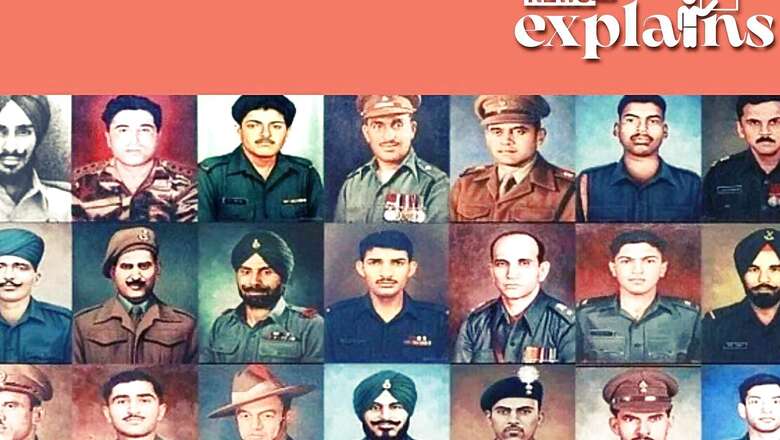
views
Prime Minister Narendra Modi on the occasion of Netaji’s 126th birth anniversary named 21 islands of Andaman and Nicobar after Param Vir Chakra awardees.
He noted that the islands will be a source of inspiration for generations to come.
“Today, it is a proud moment for me as I address the people of Andamans because this is the land, where Subhas Chandra Bose unfurled the national flag for the first time in 1943,” he said.
Earlier, Union Home Minister Amit Shah lauded the initiative to christen the 21 islands, and said this effort will be a source of encouragement for the country’s armed forces.
What is the Param Vir Chakra?
The Param Vir Chakra (PVC) is India’s highest military decoration, bestowed upon those who have displayed distinguished acts of valour during wartime. The award translates into “most conspicuous bravery in the presence of the enemy.”
Who are the Islands Named After?
The largest unnamed island was named after Major Somnath Sharma, India’s first Param Vir Chakra recipient, who received the award posthumously in 1950.
Other islands were named after other PVC awardees, such as Subedar and Hony Captain (then Lance Naik) Karam Singh, 2nd Lt Rama Raghoba Rane, Naik Jadunath Singh, Company Havildar Major Piru Singh, Capt GS Salaria, Lieutenant Colonel (then Major) Dhan Singh Thapa, Subedar Joginder Singh, Major Shaitan Singh, Lance Naik Albert Ekka.
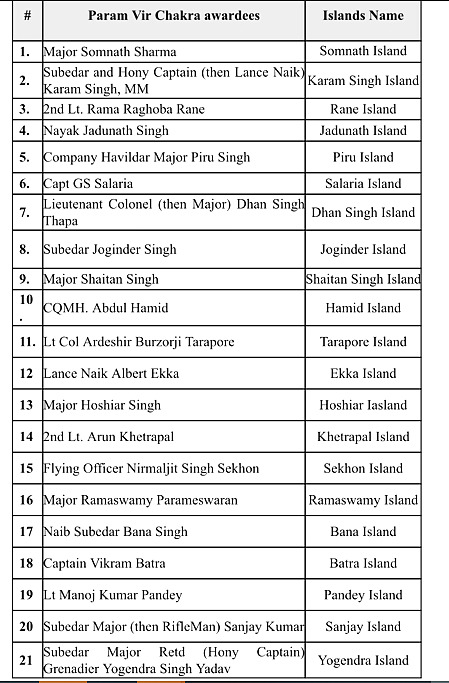
Major Somnath Sharma
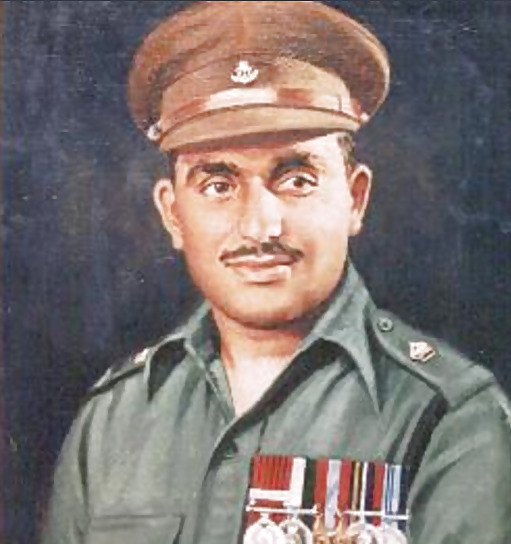
- Somnath Sharma was killed in action on 3 November 1947 while repelling Pakistani infiltrators near Srinagar Airport during the Indo-Pakistani War of 1947-1948. He was posthumously awarded the Param Vir Chakra for his gallantry and sacrifice during the Battle of Badgam.
Captain Karam Singh MM
- Subedar and Honorary Captain Karam Singh MM joined the army in 1941 and participated in World War II’s Burma Campaign, earning the Military Medal for his actions during the Battle of the Admin Box in 1944.
- He also fought in the 1947 Indo-Pakistani war, earning the PVC for his role in rescuing a forward post at Richhmar Gali, south of Tithwal.

- He was also one of five soldiers chosen in 1947 to raise the Indian flag for the first time after independence. Singh later rose to the rank of subedar and was appointed honorary captain before retiring in September 1969.
Major Rama Raghoba Rane
- Major Rama Raghoba Rane was the first living recipient of the Param Vir Chakra along with Karam Singh.
- Rane, who was born in 1918, served in the British Indian Army during WWII. He remained in the military after the war, and on December 15, 1947, he was commissioned in the Bombay Sappers Regiment of the Indian Army’s Corps of Engineers.
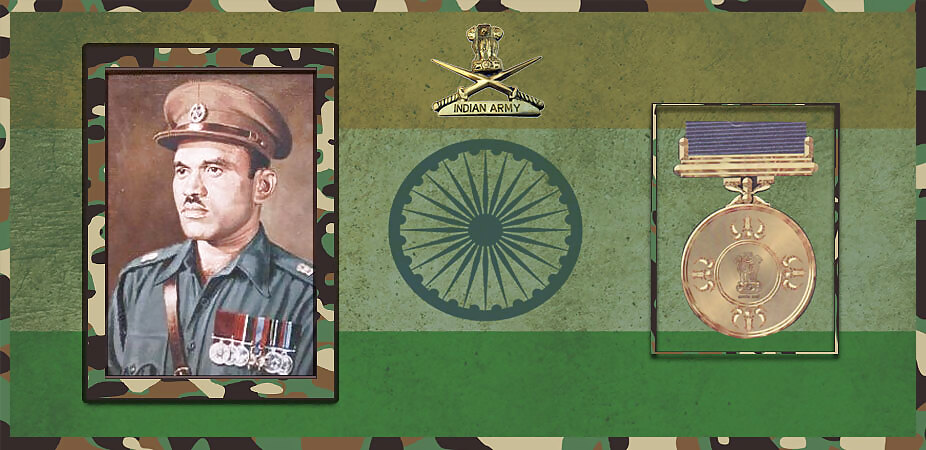
- During the 1947 Indo-Pakistani War, Rane was instrumental in clearing several roadblocks and minefields, which enabled Indian forces to capture Rajauri. His actions paved the way for Indian tanks to advance. On April 8, 1948, he was awarded the Param Vir Chakra for his valour.
Nayak Jadunath Singh
- Jadunath Singh was posthumously awarded the Param Vir Chakra for his actions during the 1947 Indo-Pakistani War.
- Singh joined the British Indian Army in 1941 and fought against the Japanese in Burma during World War II. He later served in the Indian Army during the 1947 Indo-Pakistani War.

- Nayak Singh was awarded the Param Vir Chakra for an action on 6 February 1948 at Tain Dhar, north of Naushahra. Singh was in charge of a nine-man forward section post. Despite being outnumbered by advancing Pakistani forces, he led his men in repelling three attempts to take the post. During the second assault, he was injured. Armed with a Sten gun, he charged the third assault with such zeal that the attackers were forced to retreat. He was killed in the process. Singh is commemorated by a sports stadium in Shahjahanpur and a crude oil tanker.
Major Havildar Company Piru Singh Shekhawat
- Major Havildar Company Piru Singh Shekhawat was a non-commissioned officer in the Indian Army. On 20 May 1936, Singh enlisted in the British Indian Army and was assigned to the 1st Punjab Regiment. He served on the North-West Frontier and as an instructor between 1940 and 1945 before being assigned to the British Commonwealth Occupation Force in Japan.
- Following independence, he served with the Indian Army’s 6th Rajputana Rifles in the 1947 Indo-Pakistani War. During the battle, Singh was part of a company that was tasked with capturing a Pakistani post in Tithwal, Jammu and Kashmir. The company suffered heavy casualties soon after their attack began. Singh eventually took over a Pakistani medium machine-gun post. However, by that time, the entire company had been killed or injured. Singh was left alone to complete the task. He advanced and lobbed grenades at the next enemy position. He received a fatal bullet wound to the head.
Captain Gurbachan Singh Salaria
- Captain Gurbachan Singh Salaria was a member of the Indian Army and a member of a United Nations peacekeeping force. Salaria attended King George’s Royal Indian Military College as well as the National Defence Academy. He is the only UN Peacekeeper to have received the PVC.
- Salaria was one of the Indian troops deployed to the Republic of the Congo as part of the United Nations Operation in the Congo in December 1961. On the 5th of December, Salaria’s battalion was tasked with clearing a roadblock manned by 150 gendarmes from the secessionist State of Katanga on their way to Elizabethville Airport. Salaria and his men were supposed to obstruct their escape. The Katangese armoured cars were attacked and destroyed by his rocket launcher team.
- This unexpected move perplexed the gendarmerie, so Salaria decided to attack before they reorganised. Despite being outnumbered, his troops charged the Katangese and killed 40 men in a kukri assault. Salaria was shot twice in the neck during the attack and died as a result of his injuries.
- The remaining gendarmes fled in confusion, abandoning their dead and injured. The main battalion was able to easily overrun the Katangese and clear the roadblock as a result of this. Salaria was awarded the PVC for his duty and courage, as well as his disregard for his own safety during the battle.
Lieutenant Colonel Dhan Singh Thapa Magar

Subedar Joginder Singh

Major Shaitan Singh Bhati
- Major Shaitan Singh Bhati was born in the state of Rajasthan. Singh joined the Jodhpur State Forces after graduating. After the princely state of Jodhpur was absorbed into India, he was transferred to the Kumaon Regiment. He took part in operations in the Naga Hills as well as the Indian annexation of Goa in 1961.
- During the Sino-Indian War of 1962, the Kumaon Regiment’s 13th Battalion was stationed in the Chushul sector. C Company, under Singh’s command, was stationed at Rezang La. The Chinese launched an attack in the early hours of November 18, 1962. After several failed frontal assaults, the Chinese launched an attack from behind.
- The Indians fought until the final rounds before being defeated by the Chinese. Throughout the battle, Singh moved from post to post, reorganising defences and boosting his men’s morale.
- He was seriously injured while moving between the posts without cover, and he died as a result of his injuries. Singh was awarded the Param Vir Chakra for his actions on November 18, 1962.
Company Quartermaster Havildar Abdul Hamid
- Company Quartermaster Havildar Abdul Hamid received the Param Vir Chakra, posthumously for his actions during the Indo-Pakistani War of 1965.
- Hamid joined the army in December 1954 and was assigned to the Grenadiers’ 4th Battalion. During the Sino-Indian War, his battalion fought against the People’s Liberation Army at Namka Chu. During the Indo-Pakistani War of 1965, the 4 Grenadiers battalion was entrusted with a critical position on the Khem Karan-Bhikhiwind line before the village of Chima. During the Battle of Asal Uttar on September 9-10, 1965, Hamid destroyed eight Pakistani tanks and was killed while destroying the ninth.
Lieutenant Colonel Ardeshir Burzorji Tarapore
- Lieutenant Colonel Ardeshir Burzorji Tarapore joined the Hyderabad Army after finishing his education in Pune and was commissioned in January 1942. He initially joined the infantry but was later transferred to the 1st Hyderabad Imperial Service Lancers, an armoured regiment. Tarapore saw action in the Middle East during WWII.
- Tarapore was chosen to join the Indian Army after Hyderabad State was annexed by India in 1948. In April 1951, he was commissioned again and assigned to the Poona Horse regiment’s 17th Battalion. Later, he attended a Centurion tank training course in the United Kingdom. He served in the Sialkot sector during the Indo-Pakistani War of 1965 and led the regiment in several tank battles between September 11 and September 16, and was killed in one of them at Butur-Dograndi on September 16. The regiment destroyed sixty Pakistani tanks under his command, while the Indians lost nine.
Lance Naik Albert Ekka
- Lance Naik Albert Ekka was posthumously awarded the PVC. During the 1971 Indo-Pakistan war, he was killed in action during the Battle of Gangasagar.
- His Param Vir Chakra citation:
“ Lance Naik Albert Ekka was in the left forward company of a battalion of the Brigade of Guards during their attack on the enemy defences at Gangasagar on the Eastern front. This was a well-fortified position held in strength by the enemy. The assaulting troops were subjected to intense shelling and heavy small-arms fire, but they charged onto the objective and were locked in bitter hand-to-hand combat.
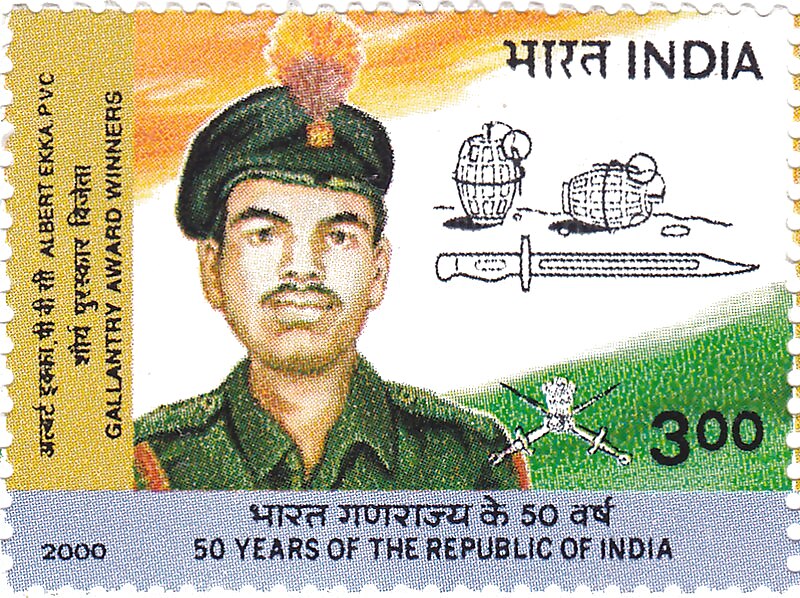
Lance Naik Albert Ekka noticed an enemy light machine-gun (LMG) inflicting heavy casualties on his company. With complete disregard for his personal safety, he charged the enemy bunker, bayoneted two enemy soldiers and silenced the LMG. Though seriously wounded in this encounter, he continued to fight alongside his comrades through the mile deep objective, clearing bunker after bunker with undaunted courage. Towards the northern end of the objective one enemy medium machine-gun (MMG) opened up from the second storey of a well-fortified building inflicting heavy casualties and holding up the attack.
Once again this gallant soldier, without a thought for his personal safety, despite his serious injury and the heavy volume of enemy fire, crawled forward till he reached the building and lobbed a grenade into the bunker killing one enemy soldier and injuring the other.
The MMG however continued to fire. With outstanding courage and determination Lance Naik Albert Ekka scaled a side wall and entering the bunker, bayoneted the enemy soldier who was still firing and thus silenced the machine-gun, saving further casualties to his company and ensuring the success of the attack. In this process however, he received serious injuries and succumbed to them after the capture of the objective. In this action, Lance Naik Albert Ekka displayed the most conspicuous valour and determination and made the supreme sacrifice in the best traditions of the Army. ”
Colonel Hoshiar Singh Dahiya
- Colonel Hoshiar Singh Dahiya received the Param Vir Chakra, during the 1971 Indo-Pakistani war.
- His citation reads:
“On 15 December 1971, during India-Pakistan War Major Hoshiar Singh was commanding a company of 3 GRENADIERS and was ordered to capture the enemy locality of Jarpal. During the assault, his company came under intense shelling. Undeterred, he led the charge and captured the objective after a fierce hand-to-hand fight.
The enemy reacted and put in several counter attacks. Despite being wounded he moved from trench to trench motivating his soldiers to shoot every enemy in sight. At that time, an enemy shell landed near the Medium Machine Gun post, injuring the crew and rendering it inoperative.
Major Hoshiar Singh, realizing its importance, rushed and manned the gun, inflicting heavy casualties on the enemy. The attack was successfully repulsed and the enemy retreated. For his dauntless leadership and indomitable fighting spirit, he was awarded the Param Vir Chakra.”
Second Lieutenant Arun Khetarpal
- Second Lieutenant Arun Khetarpal was a posthumous recipient of the Param Vir Chakra.
- He was killed in action during the Indo-Pakistan War of 1971 in the Battle of Basantar on the Battlefield of Shakargarh, where his actions earned him the honour.
- His PVC citation reads:
- “At 08:00 hours on 9 December, Pakistani armour launched the first of their counter-attacks under the cover of a smokescreen at the pivot of the 17th Poona Horse at Jarpal. At 08:00 hours, the Pakistani 13th Lancers, equipped with the then state-of-the-art US-made 50 ton Patton tanks, launched the first of their counter-attacks under the cover of a smokescreen at ‘B’ Squadron, The Poona Horse, at Jarpal.
Its squadron commander urgently called for reinforcements. Arun Khetarpal, who was in ‘A’ squadron and was stationed close by with his Centurion tank troop, responded with alacrity, as did the rest of his regiment. The first counter-attack was decimated by accurate gunnery, coolness by Indian tank troop and individual tank commanders from the CO, Lt Col Hanut Singh down to its troop leader, Arun Khetarpal. The 13th Lancers desperately launched two more squadron-level counter-attacks and managed to achieve a breakthrough.
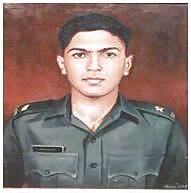
Khetarpal rushed to meet the Pakistani armour and launched right into the Pakistani attack. With his troop, he was able to run over the enemy advance with his tanks. However, the commander of the second tank was killed in this attack. Alone in charge, Khetarpal continued his attack on the enemy strongholds. The enemy fought very bravely and did not retreat even after taking losses. Disappointed by his failure so far, he desperately attacked the incoming Pakistani troops and tanks, knocking out a Pakistani tank in the process. However Pakistani forces regrouped and counter-attacked. In the ensuing tank battle, Lt. Arun Khetarpal with his 2 remaining tanks fought off and destroyed 10 tanks before he was killed in action.
“No, Sir, I will not abandon my tank. My main gun is still working and I will get these bastards.”
Then he set about destroying the remaining enemy tanks. The last enemy tank, which he shot, was barely 100 metres from his position. At this stage, his tank received a second hit and he was seriously injured. The officer met his death trying to deny the Pakistani Army its desired breakthrough.”
Flying Officer Nirmal Jit Singh Sekhon
- Flying Officer Nirmal Jit Singh Sekhon was an Indian Air Force officer. During the Indo-Pakistani War of 1971, he was posthumously awarded the Param Vir Chakra for his lone defence of Srinagar Air Base against a Pakistan Air Force (PAF) air raid. He is the only Indian Air Force member to have received the PVC.
- The exact location of Nirmal Jit Singh Sekhon’s aircraft crash site and his aircraft, are still unknown.
Major Ramaswamy Parameswaran
- Major Ramaswamy Parameswaran known as Parry to his colleagues, was an Indian Army officer who was awarded the Param Vir Chakra for his bravery. On January 16, 1972, Parameshwaran received a Short Service Commission as a second lieutenant in the 15th Battalion Mahar Regiment.
- After being promoted to lieutenant on January 16, 1974, he was given a regular commission and promoted to captain on October 12, 1979, and major on July 31, 1984.
- Major Ramaswamy Parameswaran was returning from a search operation in Sri Lanka late at night on 25 November 1987 when his column was ambushed by a group of militants armed with five rifles. He encircled the militants from behind and charged into them, completely surprising them.
- During the hand-to-hand combat, a militant shot him in the chest. Unfazed, Major Parameswaran snatched the militant’s rifle and shot him dead. Despite being severely injured, he continued to issue orders and inspire his command until his death. Five militants were killed, three rifles and two rocket launchers were recovered, and the ambush was cleared.
Captain Bana Singh
- Captain Bana Singh is a recipient of the Param Vir Chakra, the nation’s highest gallantry award. He led the team that wrested control of the highest peak on the Siachen Glacier in Kashmir from Pakistani forces as part of Operation Rajiv as a Naib Subedar in the Indian Army.
- Following his success, India renamed the peak (previously known as Quaid Post by Pakistanis) in his honour as Bana Post.
Vikram Batra
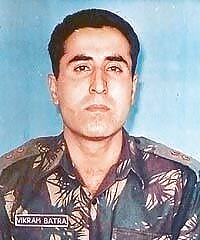
Captain Manoj Kumar Pandey
- Captain Manoj Kumar Pandey was an Indian Army officer who was posthumously awarded the Param Vir Chakra for his audacious courage and leadership during the Kargil War in 1999. He died in battle on Jubar Top of the Khalubar Hills in Kargil’s Batalik Sector as an officer of the 1st battalion, 11 Gorkha Rifles
- During his Services Selection Board (SSB) interview prior to selection, the interviewer asked him, “Why do you want to join the Army?” “I want to win the Param Vir Chakra,” he said right away.
Major Subedar Sanjay Kumar
- Major Subedar Sanjay Kumar is an Indian Army Junior Commissioned Officer and recipient of the Param Vir Chakra.
- During the Kargil War, he was the leading scout of a team tasked with capturing Area Flat Top as a member of the 13th Battalion, Jammu & Kashmir Rifles. Pakistani troops occupied the area. After scaling the cliff, the team was pinned down by machine gun fire from an enemy bunker located approximately 150 metres away.
- Realizing the gravity of the situation and the importance of this bunker in the capture of Area Flat Top, Kumar crawled alone up the ledge, along a flank, and charged towards the enemy bunker through a hail of automatic fire. He was shot twice in the chest and forearm almost instantly, causing him to bleed profusely.
- Despite his bullet wounds, he continued his charge towards the bunker. During hand-to-hand combat, he killed three enemy soldiers. He then crept towards the second enemy bunker, picking up an enemy machine gun. He killed the enemy soldiers as they fled their post, taking them completely by surprise. The rest of the platoon was inspired by his performance and charged, assaulted the feature, and captured Area Flat Top.
- He was promoted to Subedar Major in February 2022 and assigned to the National Defence Academy in Khadakwasla, near Pune.
Subedar Major and Honorary Captain Yogendra Singh Yadav
- Subedar Major and Honorary Captain Yogendra Singh Yadav PVC is a retired Indian Army commissioned officer who received the highest Indian military honour decoration, the Param Vir Chakra, for his actions during the Kargil War. He is the youngest recipient of the medal, having received it at the age of 19.
- Yadav joined the 18 Grenadiers and was assigned to the Ghatak Force commando platoon, which was tasked with capturing three strategic bunkers on Tiger Hill in the early morning hours of July 4, 1999.
- The bunkers were built at the top of a 1,000-foot (300-meter) snow-covered cliff face. Yadav volunteered to lead the assault, climbing the cliff face and installing ropes to allow additional assaults on the feature. Halfway up, an enemy bunker opened fire with machine guns and rockets, killing the platoon commander and two others.
- Despite being hit by multiple bullets in his groyne and shoulder, Yadav climbed the final 60 feet (18 m) to the summit. Despite his injuries, he crawled to the first bunker and lobbed a grenade, killing four Pakistani soldiers and putting an end to enemy fire. This allowed the rest of the platoon to climb up the cliff face bunker with two other soldiers and engage in hand-to-hand combat, killing four Pakistani soldiers. Tiger Hill was eventually captured by the platoon. Despite being hit by 12 bullets, Yadav played a significant role in its capture.
- The Param Vir Chakra was awarded posthumously to Yadav, but it was soon discovered that he was recovering in a hospital and that his namesake had been killed in the mission.
Read all the Latest Explainers here


















Comments
0 comment